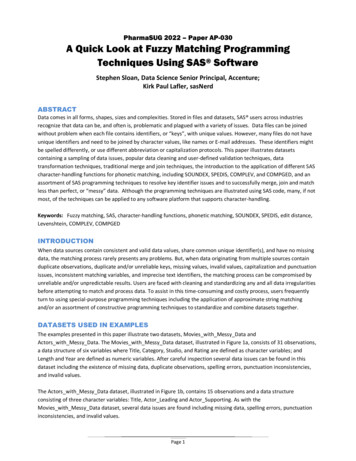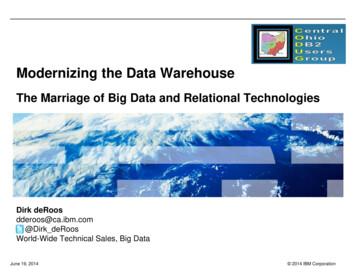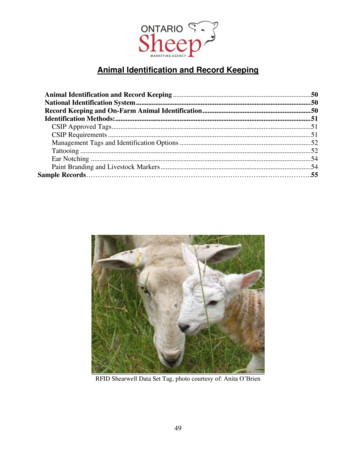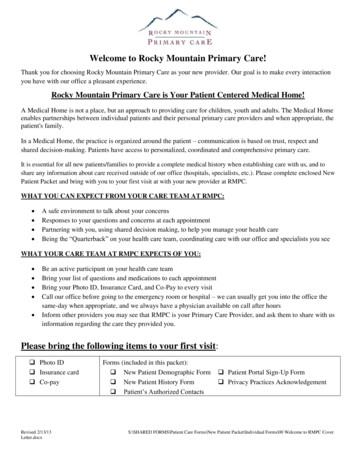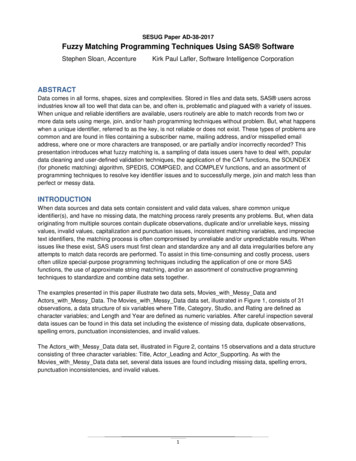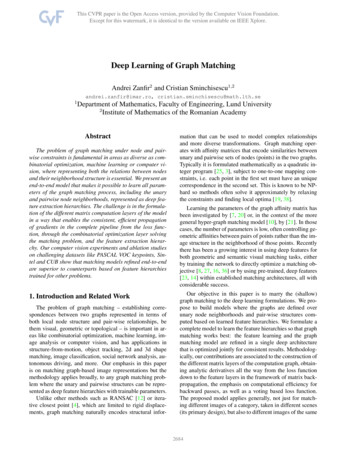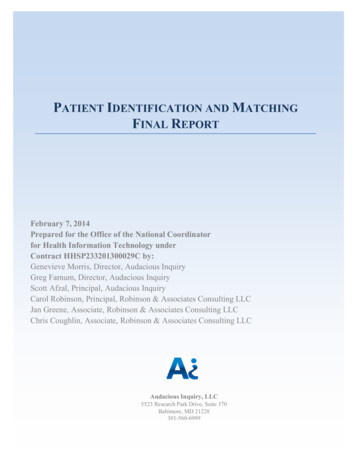
Transcription
PATIENT IDENTIFICATION AND MATCHINGFINAL REPORTFebruary 7, 2014Prepared for the Office of the National Coordinatorfor Health Information Technology underContract HHSP233201300029C by:Genevieve Morris, Director, Audacious InquiryGreg Farnum, Director, Audacious InquiryScott Afzal, Principal, Audacious InquiryCarol Robinson, Principal, Robinson & Associates Consulting LLCJan Greene, Associate, Robinson & Associates Consulting LLCChris Coughlin, Associate, Robinson & Associates Consulting LLCAudacious Inquiry, LLC5523 Research Park Drive, Suite 370Baltimore, MD 21228301-560-6999
Office of the National Coordinator for Health Information TechnologyPatient Identification and Matching Final ReportFebruary 7, 2014Table of ContentsEXECUTIVE SUMMARY . 2INTRODUCTION. 5OVERVIEW OF ENVIRONMENTAL SCAN . 5FINDINGS . 15APPENDIX A: LITERATURE REVIEW . 24APPENDIX B: BEST PRACTICES FOR DATA QUALITY . 34APPENDIX C: ENVIRONMENTAL SCAN: HEALTH SYSTEMS. 44APPENDIX D: HEALTH INFORMATION ORGANIZATIONS (HIOS) . 50APPENDIX E: EHR VENDORS . 59APPENDIX F: MDM/MPI/HIE VENDORS . 63APPENDIX G: ASSOCIATIONS AND OTHER ORGANIZATIONS . 71APPENDIX H: GLOSSARY. 82APPENDIX I: STRUCTURED INTERVIEW QUESTIONS. 87This report was created by Audacious Inquiry, LLC under a contract with the Office of the National Coordinator forHealth Information Technology (ONC). The content, views, and opinions do not necessarily reflect those of theDepartment of Health and Human Services or ONC.1 Page
Office of the National Coordinator for Health Information TechnologyPatient Identification and Matching Final ReportFebruary 7, 2014Executive SummaryThe United States healthcare system is marching diligently toward a more connected system of carethrough the use of electronic health record systems (EHRs) and electronic exchange of patientinformation between organizations and with patients and caregivers. The Patient Identification andMatching Initiative, sponsored by the Office of the National Coordinator for Health InformationTechnology (ONC), focused on identifying incremental steps to help ensure the accuracy of everypatient’s identity, and the availability of their information wherever and whenever care is needed.Matching records to the correct person becomes increasingly complicated as organizations sharerecords electronically using different systems, and in a mobile society where patients seek care inmany healthcare settings. Many healthcare organizations use multiple systems for clinical,administrative, and specialty services, which leads to an increased chance of identity errors whenmatching patient records. Additionally, many regions experience a high number of individuals whoshare the exact name and birthdate, leading to the need for additional identifying attributes to beused when matching patient records.While many hospitals, health systems, medical groups, and other organizations serving the healthcare industry have developed ways to improve the accuracy of matching patient records, thesemethods have not been adopted uniformly across the industry. For instance, differences in hownames and addresses are formatted in various systems has led to high rates of unmatched records,when unaffiliated organizations are participating in health information exchange (HIE). Otherissues and circumstances that lead to unmatched or mismatched records include the quality of dataas it is entered into systems at the source of patient registration, and the creation of duplicaterecords for the same patient within a system.Driven by concerns for patient safety in the event of mismatched or unmatched records and thenational imperative to improve population health and lower costs through care coordination, thisinitiative studied both technical and human processes, seeking improvements to patientidentification and matching that could be quickly implemented and lead to near-termimprovements in matching rates. The findings presented in this report have been developed withthe participation of healthcare stakeholders across many sectors and a wide geography. Lessonswere drawn from individuals and organizations working to improve patient identification andmatching on the bleeding edge of technology, as well as from those taking a systematic approach toimproving data quality within the technical systems storing patient data, through review andrework of business processes. The combination of those approaches has contributed to findingsthat suggest the standardization of specific demographic fields within health information systems,broad collaboration on industry best practices that could both inform policy and be sharednationally, and areas for further study where additional advances could be made in the future.Building on existing patient matching strategy work of ONC, from June through November 2013 anenvironmental scan was performed to assess the current industry capabilities and best practices forpatient identification and matching, with a focus on matching records between disparate2 Page
Office of the National Coordinator for Health Information TechnologyPatient Identification and Matching Final ReportFebruary 7, 2014organizations providing care for an individual. 1 The scan included a formal interview process witha diverse set of organizations representing four sectors of the healthcare industry, with a specificset of questions for large health systems and integrated delivery networks (IDNs); healthinformation organizations (HIOs); EHR vendors; and master data management (MDM)/masterperson index (MPI) and HIE vendors. Informal informational discussions were also held with a widevariety of associations representing patients, providers, hospitals, vendors, health informationmanagement workforce, and organizations maintaining patient registries for public health andresearch purposes, as well as several federal agencies. In total, more than 50 organizationsparticipated in the formal and informal interviews, which are summarized in Appendices C throughF.An intensive review of historical literature on patient matching was conducted, a summary ofwhich can be found in Appendix A. In addition, two in-person meetings were held during whichcomments and advice were sought. The first of those meetings was sponsored by the BipartisanPolicy Center and held in early November, 2013, while the second was a public meeting, held inmid-December 2013, in Washington, D.C. and accessible via the web. At the second meeting,feedback was sought from over 150 stakeholders on a preliminary version of proposed findings.Written feedback from the industry regarding the initial findings was solicited after the December2013 meeting, and additional outreach was conducted to help inform Appendix B: Best Practicesfor Data Quality.The patient identification and matching initiative was led by four guiding principles: 1) patientsafety is the driving force for improvement in patient matching, 2) the real-world impacts on theworkflow of administrative and clinical personnel must be carefully considered, 3) patientmatching is a complex problem, and therefore, improvements will be multifaceted and incrementalwith no single solution or step that is final, and 4) potential improvements should apply all sizesand types of provider settings, a range of health IT adoption levels, and a broad set of “use cases.”The guiding principles, literature review, environmental scan, feedback received at eachstakeholder meeting, and the written comments received after each meeting, informed the findings.Findings1. Standardized patient identifying attributes should be required in the relevant exchangetransactions.2. Any changes to patient data attributes in exchange transactions should be coordinated withorganizations working on parallel efforts to standardize healthcare transactions.3. Certification criteria should be introduced that require certified EHR technology (CEHRT) tocapture the data attributes that would be required in the standardized patient identifyingattributes.4. The ability of additional, non-traditional data attributes to improve patient matching should bestudied.5. Certification criteria should not be created for patient matching algorithms or requireorganizations to utilize a specific type of algorithm.1ONC formally launched the Patient Matching Initiative in September 2013.3 Page
Office of the National Coordinator for Health Information TechnologyPatient Identification and Matching Final ReportFebruary 7, 20146. Certification criteria that requires CEHRT that performs patient matching to demonstrate theability to generate and provide to end users reports that detail potential duplicate patientrecords should be considered.7. Build on the initial best practices that emerged during the environmental scan by conveningindustry stakeholders to consider a more formal structure for establishing best practices for thematching process and data governance.8. Work with the industry to develop best practices and policies to encourage consumers to keeptheir information current and accurate.9. Work with healthcare professional associations and the Safety Assurance Factors for EHRResilience (SAFER) Guide initiative to develop and disseminate educational and trainingmaterials detailing best practices for accurately capturing and consistently verifying patientdata attributes.10. Continue collaborating with federal agencies and the industry on improving patientidentification and matching processes.4 Page
Office of the National Coordinator for Health Information TechnologyPatient Identification and Matching Final ReportFebruary 7, 2014IntroductionOver the last few years, the healthcare industry has been working towards meeting the Triple Aimof improving patient care, improving population health, and reducing the cost of healthcare.2Accurately identifying patients and correctly matching their data, particularly as electronic databecomes more prevalent, is a key component to ensuring the Triple Aim can be met. If patient datais not accurately matched within and across organizations, treatment and diagnosis decisions willbe made in the absence of valuable information and patients could be subject to adverse events andsignificant harm. To facilitate the best possible treatment and care coordination among a care team,exchanging and linking patient data from each point of care is critical. In order to improve theefficiency of the healthcare system, duplicative testing, treatment decisions made in the absence ofdata, and inaccurate billing must be reduced; none of which can be accomplished without correctlyidentifying patients at the point of care and accurately matching their records as they are sharedacross organizations. Current methods to match patient records cannot achieve a zero percenterror rate in which every possible match is correctly made and erroneous matches are avoided.Indeed, no single solution can accomplish this feat given the underlying contributors to thechallenge of accurate record linking. However, the environmental scan and the December 2013stakeholder meeting indicate that a multi-faceted approach to improve patient matching can makeincremental progress to improve the current average match rates in the industry.Overview of Environmental ScanObjectiveThe environmental scan of patient matching practices describes current practices and trends in thehealth care industry, particularly pertaining to sharing clinical information. Health careorganizations and their technology vendors continue to implement varying patient matchingprocesses and technology. This lack of commonality poses a threat to patient safety andorganizational efficiency, and both problems are likely to be magnified as HIE activities continue togrow in various forms across the country. The goal of the environmental scan is to document whatis happening among larger health systems and HIOs throughout the United States, the approachessoftware vendors are taking to address customer needs, and whether there are best practices thatcould be gleaned from thoughtful organizations. The scan is only a snapshot of organizations ratherthan an academic survey. However, special emphasis was placed on gathering information from aswide a variety of stakeholders as possible within the time constraints of the initiative.Choice of ParticipantsInterviewees selected for the structured portion of the scan were organized into four industrycategories to provide varied perspectives on patient matching. The categories included healthsystems, HIOs, MDM/MPI solution vendors, HIE vendors, and inpatient or outpatient EHR vendors.Up to nine participants (hereafter referred to as organizations) were chosen in each category for2Institute for Healthcare Improvement: Triple Aim s/TripleAim/Pages/default.aspx5 Page
Office of the National Coordinator for Health Information TechnologyPatient Identification and Matching Final ReportFebruary 7, 2014interviews with a predetermined list of questions unique to their industry category.3 Interviewparticipants were chosen to reflect a balance of geography, size, vendor partners, and the type oforganization. In addition, the project team held unstructured conversations with other interestedindustry parties including federal agencies, associations, solution companies, consumerorganizations, and individuals who represent much of the continuum of stakeholders, or who havean innovative approach to matching.4Data Collection ProcessIn-person and telephone interviews were held with more than 50 organizations and individuals.5Interviews with organizations included members of the organization’s C-Suite, health informationmanagement (HIM) department, information technology (IT), and government affairs. Theinterviews took place between September and November 2013.LimitationsAs noted above, the scan was not an academic survey. Therefore, this report will not providespecific tallies of patient matching practices, but offer generalized observations based on datacollected during the interviews. These observations are limited by the relatively small subset oforganizations, which may also have more focus on patient matching issues than the typical healthcare organization.Hospitals and Health SystemsThe environmental scan interviews included seven health systems that manage multiple hospitals,physicians, and ancillary services.6 In aggregate, the number of patients to whom they provide careis into the millions of individuals. In general, these organizations were aware of the patientmatching problem from an internal medical records management and data exchange perspective,even if concern about the issue did not typically rise above managers in the business and healthinformation technology or management departments. While several of the health systems havebegun sharing patient records externally, in general it appeared that they were just beginning tothink about the implications of incorrectly matched patients at the community level.Data AttributesThere are several common data attributes that are used by many, if not most, organizations formatching, though the format of the data attributes varies, sometimes within the organization itself(see standardization section below). The three most common attributes used for matching are thepatient’s name, date of birth, and gender. Often the patient’s phone number, address (full or ZIPcode only) is also included in the core set of attributes. The variation in data attributes used byhealth systems tends to be caused by geographical and cultural variation around the stability of3The Paperwork Reduction Act of 1980 (Pub. L. No. 96-511, 94 Stat. 2812, codified at 44 U.S.C. § 3501-3521)places limitations on federally funded surveys.4These organizations and individuals did not receive a formal list of questions prior to or during the conversation.This number includes the 32 organizations that received structured questions, and other interested industry parties.6Two health systems chose not to be included in the final report.56 Page
Office of the National Coordinator for Health Information TechnologyPatient Identification and Matching Final ReportFebruary 7, 2014each attribute. In more rural areas attributes such as phone number and address were lesstransient when compared to urban areas.While some health systems indicated that they only require three or four very stable data attributesto achieve high quality matching, several with deep experience in patient matching methods notedthat they are better served by a larger number of attributes, no matter what those attributes are.For example, Geisinger Health System collects a long list of demographics that are separated intofields: first name, middle name, last name, date of birth, gender, whole social security number,street address, city, state, ZIP, and phone.Many organizations continue to use the Social Security number (either the full number or the lastfour digits) at least internally. Fewer share Social Security numbers with providers who are neitheremployed nor affiliated with their health system. Most acknowledged that patients are becomingincreasingly unwilling to share Social Security numbers in a health care context, and that somemedical practices, hospitals, and insurance carriers have stopped collecting it. There was a strongfeeling among the organizations that a unique number can be very useful in working throughrecords of patients with the same name and birth date, but a few said Social Security number is notthat helpful. Proponents of a unique number, whatever it may be, said it helps the system be moreautomated and reduces the need for costly manual review.Organizations had an interest in historical demographics such as previous names, addresses, orphone numbers. Mayo, for instance, has been trying to collect maiden name at its Rochester site andin other areas is trying to standardize previous name. Some systems already collect previous dataattributes, but others do not or cannot. Geisinger believes that using mother’s maiden name formatching might be possible, but patients may not know it, know how to spell it, or be willing toshare it. Additionally, some hospital information systems may not have a field available for anadditional attribute such as mother’s maiden name. Health systems urged caution about anynational effort to require additional, atypical data attributes, arguing that the change in workflowfor a large organization could be quite costly. However, at least one health system encouragedgreater national commonality through regulation.A number of organizations, including those speaking at the December 16 stakeholder meeting,repeatedly mentioned the value of matching using demographic attributes that are unlikely tochange. However, they disagree on which data attributes are stable, with each noting situationswhere nearly every data attribute would be unstable. For instance, while date of birth might seemstable, some said they had seen people report varying birth dates to appear younger. Social Securitynumbers can be shared or otherwise misused or stolen. Cell phones may be increasingly stable, butthat depends on local trends in phone use. Organizations had difficulty identifying the ideal, stabledata attributes (other than a unique numerical identifier), but with further study it could bepossible to identify those least likely to have variability.StandardizationEven if similar data attributes are used across the continuum of care, often they are not stored in astandard format, introducing variation across organizations. Organizations noted that even apatient’s name can become quite complicated, with variations in whether middle name or initial is7 Page
Office of the National Coordinator for Health Information TechnologyPatient Identification and Matching Final ReportFebruary 7, 2014used, how hyphens are handled, whether previously used names or nicknames are recognized, andhow people of different ethnic backgrounds use their family names.Health systems frequently indicated that there needs to be a standardized way demographics suchas name and date of birth are entered into systems and into electronic messaging formats. Systemsthat have strong patient identity integrity governance tended to have thought through this issue forinternal sharing; Mayo Clinic, for instance, said it has established 17 standardized formats fordemographic fields to be used by anyone in the organization creating or modifying a record. Thedifferences in how various systems and organizations format their demographic attributes becomesexponentially more of a problem, when they share patient information externally.Match Methods and AlgorithmsSome organizations have developed their own matching methods and algorithms, while otherspurchased products such as IBM’s Initiate, QuadraMed, or use their EHR vendor’s product forinternal and external matching. The success of the matching methods varied based on whether theywere matching patients internally or externally across organizations. Health systems with a tightlymanaged data quality program and feedback loop appeared to be most successful in attainingmatch rates of 90 percent or higher. The match rates tended to decrease as organizations begansharing records with systems that are managed differently or have different EHR systems.Furthermore, the match rates dropped even if the same MDM/MPI vendor was used by bothorganizations. For example, Kaiser Permanente (which has 17 instances of Epic across its regions)reported a match rate of greater than 90 percent within each instance; that rate fell to around 50percent to 60 percent when sharing between regions using a separate instance of Epic or withoutside Epic partners. Other organizations cited similar declines in match rates as data is sharedacross unaffiliated organizations.Organizations varied in the type of matching processes used, including: pure deterministic (one-forone character match on specified data attributes), weighted deterministic (one-for-one charactermatch with some data attributes receiving higher “weighting” if they match or did not match; e.g. anSocial Security number match is given high weighting), and probabilistic algorithms (complex set ofweights, variable matching thresholds, accounting for transposition of characters, misspellings, andother data quality issues). Some of these approaches offer the ability to modify or tune the matchingalgorithm to manage the false positives and false negative rates. Organizations often describedadjusting matching methods to fit the kinds of data entry errors that typically occur in their patientrecords, such as adjusting the weights of different data attributes to account for the most commonerrors or to account for policies such as not asking patients for social security numbers.Manual ReviewHealth systems typically have several people in medical records or HIM departments devoted toperiodically reviewing a potential duplicates report generated by their EHR or MPI and manuallyidentifying the records that should be merged. Most said this activity would likely always benecessary because matching methods must be set to produce duplicates rather than overlays (false8 Page
Office of the National Coordinator for Health Information TechnologyPatient Identification and Matching Final ReportFebruary 7, 2014positives) as a patient safety policy.7 However, there was definite interest in keeping manual reviewto a minimum because of the cost and the potential disruption in patient care when a record, suchas a test result, is missing from the patient’s record. Intermountain reported that it had calculatedthe cost of fixing a duplicate record at 60 in operational costs. There is also widespread concernabout the implications of poorly matched records being shared outside an organization throughHIE, amplifying the errors.RegistrationThe majority of health systems recognized that accurate patient matching does not rely solely onpatient matching processes and algorithms, but that data quality, particularly at the point of entry,is equally important. Typos, misspellings, transpositions, fields left empty, or fields filled with falsedata can all cause problems downstream from the point of entry. Health system representativesacknowledged that the personnel at hospital front desks experience frequent turnover, makingtraining a challenge. Regenstrief noted that the average time of employment for their registrars isroughly four months. At the same time, they often put effort into training programs (Intermountainshared its enterprise Master Patient Index (EMPI) training module with the Audacious Inquiryteam). There is also a certification program for health care registration personnel through theNational Association for Health Access Management (NAHAM) (see NAHAM’s interview summary).There were mixed reactions to the idea of a national requirement for certification of health careregistrars, but interviewees were generally positive about the idea of sharing best practicesthrough a patient-safety campaign that could bring these training resources to smaller hospitalsand to medical practices.Patient registration processes also offer the opportunity to confirm a patient’s identity, helping toreduce the chance of a mismatched or duplicate record. Some organizations reported that theirregistrars check a photo ID, which is also helpful for reducing the risk of fraudulent use of apatient’s insurance coverage. These methods sometimes tie into a health system’s patient safetyefforts on the clinical side, where the standard of care is to confirm a patient’s identity using twoattributes (name and date of birth, typically) each time a medical test or intervention is carried out.These methods are also used to decrease the creation of a duplicate patient record. Most healthsystems, as a best practice, require registrars to search for an existing patient record beforecreating a new record. For example, Geisinger registration employees are trained to search for apatient record using a few letters of the first and/or last name to increase the chances of findingduplicate records for that patient under a nickname or misspelling. Other health systems, such asGroup Health, only allow highly-trained, upper-level staff to create a new patient record, ratherthan the first line registration staff.Group Health and Mayo Clinic both described higher-level, advanced governance initiatives aroundpatient identity. Group Health’s includes an ongoing process improvement project within the HIMdepartment that is seeking to reduce the number of duplicate records. A cross-functional teamstandardized the process for assigning new member/patient numbers and reduced the number ofdepartments that could assign numbers. Mayo Clinic described a homegrown application that is7It is generally recognized in the industry that false positives (incorrectly matching two records together) present alarger patient safety issue than false negatives (no match at all), since the wrong care could be provided based on anincorrect match.9 Page
Office of the National Coordinator for Health Information TechnologyPatient Identification and Matching Final ReportFebruary 7, 2014linked to the MPI and automatically notifies all systems when a false positive or false negative isfound. The system operators must fix the error and send a message back to the applicationindicating the error has been remediated.Finally, some organizations routinely ask patients to confirm their data at registration. Care mustbe taken during this process not to mistakenly share the screen of a different patient’s medicalinformation. Health systems are increasingly focusing more on the potential for fraudulent sharingof insurance identities, so many have added verification of picture IDs or an insurance card with aphoto or embedded electronic information, to their registration process. Others are currentlyutilizing or are implementing biometric methods (palm scans, fingerprints, etc.), with manyindicating that they believed the use of biometrics would be common in the near future. All of theorganizations currently using biometrics indicated that the biometric identification programs werevoluntary for patients. Kaiser representatives also mentioned the organization’s experiments withpatient kiosks, where members can easily access medical records and adjust incorrect demographicinformation; this raises the issue of whether patients should have the ability to changedemographic or clinical information about themselves, something that was mentioned frequently.When mentioned, organizations indicated the importance of provenance metadata, so that staffwould know that the source of the update was the patient herself.HIOsOverall, the eight HIOs interviewed viewed their role as a facilitator of patient data s
the patient identification and matching initiative was led by four guiding principles: 1) patient safety is the driving force for improvement in patient matching, 2) the real-world impacts on the workflow of administrative and clinical personnel must be carefully considered, 3) patient matching is a complex problem, and therefore, improvements

